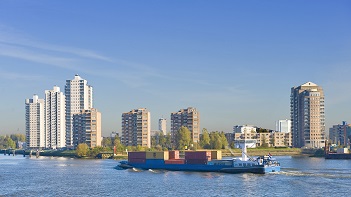Are inland waterways ready for continental cargo?
29 March 2016
According to the PLATINA2 analysis, the lack of uptake of inland shipping is hampered by cost, the availability of an appropriate multimodal unit and business models. Cooperation between logistics players and sharing of information are key to move continental cargo by water.
The macro-analysis demonstrates that 87 million tonnes of the continental cargo currently transported by road is suited for intermodal transport along to the existing waterway corridors with the potential to save up to 10% transport costs.
As a top-down approach was used to determine the continental multimodal
market potential, there was also a need to have a more bottom-
up approach to identify the current market structure of the containerized continental market and what is needed to make the shift happen. Modal shift case studies confirm the cost factor for shifting cargo. Furthermore, The 45’ pallet wide high cube short sea shipping container seems the most appropriate intermodal unit for continental container transport, but 45-feet containers are not available in large numbers in the hinterland.
But as decisive is the business model. Shifting continental cargo to inland shipping is difficult. Chain market parties do not spontaneously share information and cooperate.
In a Hub and Spoke network, one terminal serves as the hub. All of the remaining terminals transports take place via the hub, even if terminals are close to each other. The barges collecting containers at inland terminals in the hinterland sail to a hub terminal where all containers are unloaded. The containers are grouped on the hub by destination. This concept is not yet widespread but is interesting because of the advantages provided by bundling of cargo:
- Improving the efficiency of the existing services: the exchange of containers make it possible to plan fewer stops at the terminals in the seaport
- Achieving the required frequency of timetables and become a serious alternative for road transport
- Providing also a continental cargo piggyback with the maritime transport services between ports and hinterland.
The Hub and Spoke system could be the way to go for further capturing
the continental cargo flows, taking into account the identified
bottlenecks need to be solved in order to make optimal use of this
service model.
Improvement of information exchange in all kind of aspects could help to tsimulate the modal shift. Looking at the business case of the Hub and Spoke system it became clear that throughout the whole transport chain more concrete and accurate information to ptential clients and between logistics players is needed to persuade parties to shift their cargo from road to the waterway.



